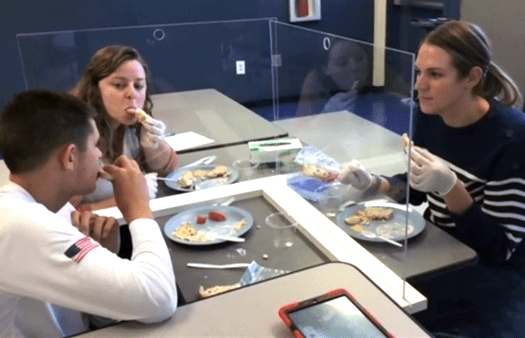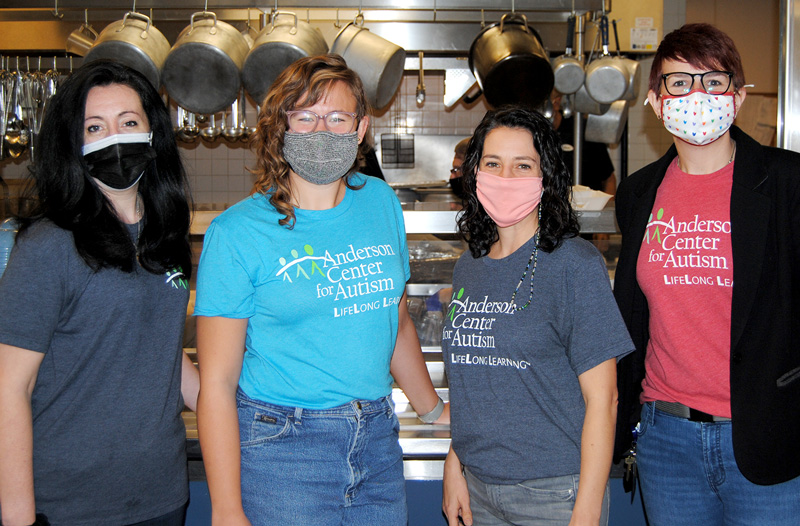Feeding and eating problems, such as selective eating, is common among individuals with Autism Spectrum Disorder (ASD). The prevalence of feeding problems in children with ASD is reported to be as high as 90%, with around 70% of individuals being described as picky eaters (Twachtman-Reilly et al., 2008; Volkert & Vaz, 2010). Unfortunately, selective eating in the ASD population can be a lifelong challenge, requiring intervention (Twachtman-Reilly et al., 2008). This article presents the interdisciplinary system used at the Anderson Center for Autism to best serve those individuals with ASD who present with selective eating.

Anderson Center for Autism Day Student, Cameron P, participating in the
MEALLS Program with Kaela Banashefski, OT and Alexandra Hopkins, SLP
Medical Implications Related to Selective Eating
Individuals on the spectrum may present as selective eaters because of pain or discomfort from GI issues such as acid reflux, constipation, eosinophilic esophagitis, and diarrhea (Babinska et al., 2020). It has been identified that children with ASD may not express or verbalize their pain or discomfort, so parents and caregivers are suggested to be proactive and find what in a child’s diet could be causing discomfort (Garey, 2020). Here at Anderson Center for Autism, we take the approach of ruling out medical first. We understand that there are various reasons for a child with ASD to become a selective eater, including medical implications.
In addition to gastrointestinal concerns, we also consider oral health issues. GI conditions and dental problems may affect a child’s overall health, including, but not limited to, inadequate nutrition, suboptimal growth, obesity, tooth decay, and nutritional deficiencies such as vitamins, minerals, and amino acids (Vissoker et al., 2015). Additionally, selective eating itself can also be a source of tooth decay. This decay may occur if individuals do not receive adequate nutrition, or their food repertoire consists of cavity causing agents (Vissoker et al., 2015).
At Anderson Center for Autism, we have a selective eating committee that works extensively with select individuals who present as selective eaters. Before entering our MEALLS (Making Eating a Lifelong Learning Skill) program, nurses, and medical and dental providers rule out any issues that may be causing or contributing to selective eating. This approach will ensure that the individuals receiving this specialized service will have the most optimal outcome when tackling selective eating issues.

From left to right: L-R: Gina Willamson, Amanda Adams, Rebecca Stanmyer, Alex Mellor
Making Eating a Lifelong Learning Skill (MEALLS)
Identification of the cause for the selectivity and an evidence-based intensive treatment needs to be implemented to expand a food repertoire. One way to decrease selectivity and increase food acceptance is by starting a selective eating program. At Anderson Center for Autism, we have done just that. Each school year, the Selective Eating Committee selects several individuals to be a part of our MEALLS program. To participate in the program, individuals have to meet one of the following acceptance criteria: only eat the same foods for all meals, only like a particular texture of foods, or never consume the main offered meal. First, a list of suggested individuals is compiled. Based on the nutritional need (e.g., underweight, overweight, current caloric intake) and prerequisite skills (e.g. joint attention, following verbal directions and ability to follow a visual model), an individual is identified as a candidate for feeding therapy.
Once a student is identified, the feeding therapists (SLP and OTR/L) arrange for 1.5 hours dedicated to feeding therapy one time per week. The MEALLS program is based on the SOS Approach to Feeding, which uses a multi-step process to eating, beginning with sensory systems (Toomey, 2002). The focus is on systematic desensitization techniques to make mealtimes and new/non-preferred foods a positive experience. The individual’s range of preferred foods is addressed first because research has demonstrated that the range of preferred foods drives volume consumed (Toomey, 2002). Individuals are given opportunities to try foods more than once to determine if they like the food. The primary focus of this program is not to eat/consume, but to interact with the food. This focus creates positive relationships with the food and mealtimes itself, as many selective eaters may have had negative experiences with food that they are being asked to eat. The goal is to make mealtimes enjoyable again.
Food is provided in “food hierarchies,” which consist of one protein, one starch, one fruit/vegetable, one drink, one hard munchable (i.e., jerky, large carrot), one meltable hard solid (i.e., cracker, Cheeto), and one puree. Each food is linked to the following food item by one or more sensory properties (i.e., all stick-shaped, all the same color, etc.) (Toomey, 2002). The linking of each food is essential for transitioning between the foods. Each food is presented one at a time, and the step at which the client enters engagement with the food is recorded (i.e., tolerates, interacts with, smells, touch, taste, eat) (Toomey, 2002). As feeding therapy progresses, the child is never forced to taste the food but encouraged to move up the food hierarchy, maintaining a positive environment (Toomey, 2002).
To incorporate the team, a third trained feeding therapist remains behind a one-way mirror, or now via Zoom, to explain the process to all team members observing. Examples of team members who attend a session include the residence manager, family members, the teacher, teaching assistants, and the dietician. All team members are highly encouraged to attend a feeding session to promote the highest chance for generalization of the skills outside of the feeding therapy session.
Upon completing the program, the feeding therapists consume lunch with the student and informally continue to carryover feeding therapy, addressing any concerns that arise from the team. Post-therapy food log data is collected three months after the conclusion of the formal feeding therapy sessions and is analyzed by the dietician. Overall, individuals who participate in the MEALLS respond positively to feeding therapy, with gains made in a wide variety of food groups consumed.
Conclusion
Little is known about the behavioral and physiological effects of early and ongoing poor nutrition as a result of selective eating (Volkert & Vaz, 2010). While early intervention has been shown to be effective, research continues to need to be done on the effectiveness of novel treatments for those presenting with selective eating into their adolescence (Volkert & Vaz, 2010). Our model of medical review to identify GI concerns (Babinska et al., 2020; Garey, 2020; Vissoker et al.., 2015), and a sensory approach to feeding (Toomey, 2002), has demonstrated success in expanding acceptability of new foods in students trialed. We look forward to continuing to use interdisciplinary and evidenced-based approaches to expand healthy food repertoires in our student body.
Rebecca Stanmyer, MS, CCC-SLP, is Coordinator of Related Services, Gina Williamson, RN, BSN, is Health Services Coordinator, Alex Mellor, MA, BCBA, LBA, is Assistant Principal, and Amanda Adams, MA, BCBA, LBA, is Children’s Behavior Services Coordinator at Anderson Center for Autism. For more information, visit www.andersoncenterforautism.org.
References
Babinska, K., Celusakove, H., Belica, U., Szapuova, A., Waczulikova, I., Nemciscova, D., Tomovo, A., & Ostatnikova, D. (2020). Gastrointestinal symptoms and feeding problems and their associations with dietary interventions, food supplement use, and behavioral characteristics in a sample of children and adolescents with autism spectrum disorders. International Journal of Environmental Research and Public Health, 17(17), doi: 10.3390/ijerph17176372
Garey, J. (2020). Autism and Picky Eating. Child Mind Institute. https://childmind.org/article/autism-and-picky-eating/
Toomey, K. A. (2002). When children won’t eat: The SOS approach to feeding. Denver, CO: Toomey & Associates.
Twachtman-Reilly, J., Amaral, S. C., & Zebrowski, P. P. (2008). Addressing feeding disorders in children on the autism spectrum in school-based settings: Physiological and behavioral issues. Language, Speech, and Hearing Services in Schools, 39, 261-272.
Volkert, V. M., & Vaz, P. C. M. (2010). Recent Studies on Feeding Problems in Children with Autism. Journal of Applied Behavior Analysis, 43, 155-159
Vissoker, R. E., Latzer, Y., & Gal, E. (2015). Eating and feeding problems and gastrointestinal dysfunction in Autism Spectrum Disorders. Research in Autism Spectrum Disorders, 12, 10-21.




